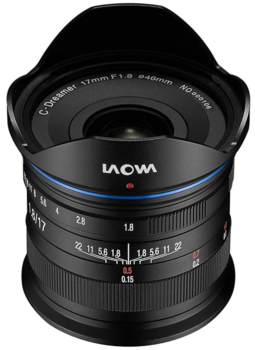Subscribe to blog updates via email »
September 2022 Income Report
An audio version of this income report is available to Patreon backers of certain levels »
September’s income was $7,795, down from August’s $11,295. Profits were $3,869, down from August’s $8,619.


WANT TO WRITE A BOOK?
Download your FREE copy of How to Write a Book »
(for a limited time)
11-month streak of record annual self-published book revenue
My self-published book revenue over the past twelve months is a record once again. I’ve made $82,041 on self-published books over the past year. I’ve broken that record eleven months in a row.
Mind Management, Not Time Management featured in Kirkus Reviews Magazine!
I’m continuing to get mileage from the $375 Kirkus review I bought in June. My review was featured in the October 1st issue of Kirkus’s magazine.
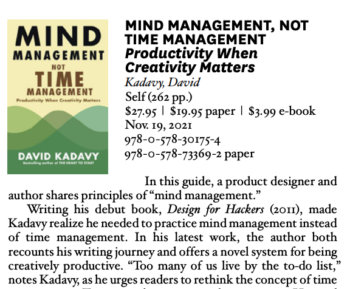
I’ve considered placing ads in Kirkus’s magazine as well, but I’ve watched my sales on Ingram Spark following this published review, and thus far I haven’t seen convincing evidence that this feature did anything to immediately drive sales. Of course, print advertising is probably even less likely to drive sales after a single impression, so I may try it anyway.
New The Heart to Start cover
I’ve been experimenting with a new cover on the Kindle edition of The Heart to Start.
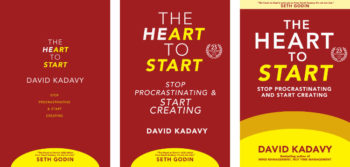
The evolution of the HTS Kindle cover
This is part of an effort to give all books in the Getting Art Done series a cohesive look. As you can see, the “sun” shape on the cover of HTS lines up with the “hills” shape on the cover of Mind Management, Not Time Management. The shape on the cover of the third book, which I’m working on, would be in the inverse shape of the HTS “sun”, and also line up.
The goal is to make these covers look as if they belong together in some way, but different enough to be different books. I’m starting this experiment with the Kindle edition, and once I’m sure I like that cover, I will change accordingly the cover of the paperback edition of HTS. I also may take advantage of the new case-laminate with dust-jacket IngramSpark hardcover to mimic the design of MMT.
@davidkadavy #nonfictionbooktok #selfhelptok #timemanagementskills #booktoker ? Forever - Labrinth
I can simply change the cover design of the Kindle or paperback version by uploading a file. But, unfortunately, if I want to change to a case-laminate with dust-jacket hardcover version of HTS, I’ll have to buy a new ISBN. I suppose I would then take the existing digital-cloth with dust-jacket out of circulation.
Experimenting with a new HTS cover is also designed to motivate me work on the third book in the series. Just seeing the new HTS Kindle cover next to the MMT cover on Amazon gets me more excited about completing the puzzle.
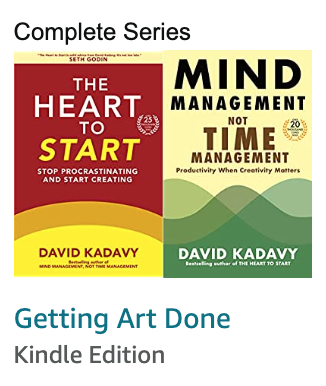
The road to 25,000 copies
Now that Mind Management, Not Time Management has surpassed the 20,000-copies-sold milestone, I have my sights on the 25,000-copy mark. As of the end of September, I have sold 21,744 copies. In other words, 3,256 copies away from 25k.
The 1,000-copy hash marks on the sales graph are getting so crowded, I considered for a moment eliminating them, and leaving only the 5,000-copy marks.
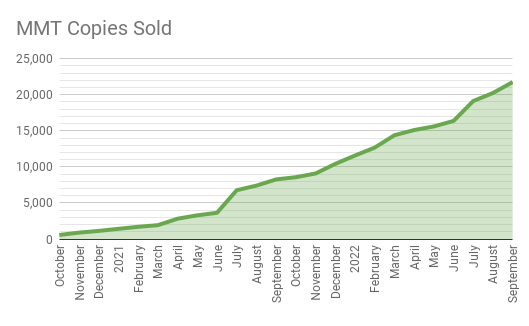
Current sales graph for MMT
But then I decided I liked how those 1,000 copy marks remind me how far the book has come. I mean, remember what the 10,000 copy sales graph looked like last December?
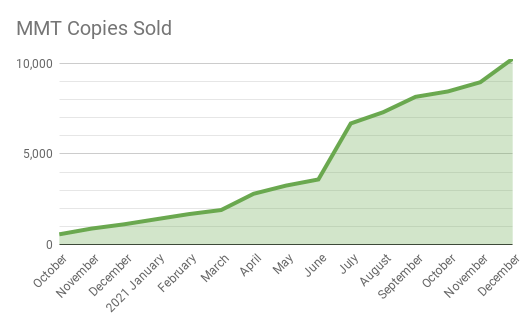
Sales graph when MMT crossed 10k
By the way, look at how profits have accelerated.
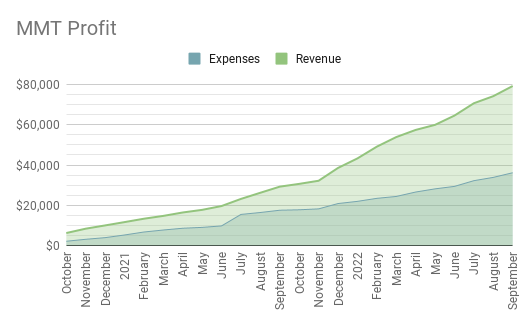
And copies sold per month are on a highly-variable but upward trend.
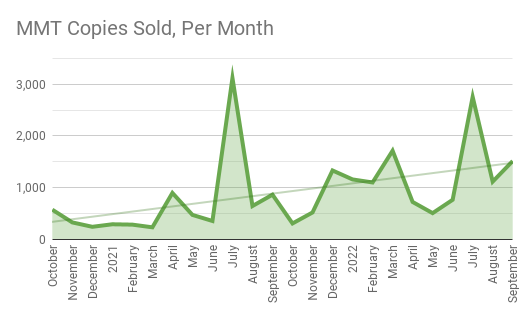
As much as I’d love to add those extra 3,256 copies in time for November’s report, I’m 70% sure I’ll reach 25k copies by the end of the year.
I bought a house! (and moved to the country)
I did something I never thought I would do: I bought a house. I’m definitely in the camp of people who believe a house is not a good investment, and I’m still frightened of how home ownership might negatively affect my creative productivity.
Getting control over my health
But, a number of things colluded to make me finally do this. The major factor is control over my health. Over the past few years, I’ve discovered how adversely EMFs – especially “dirty electricity” – affect my ability to sleep, concentrate, and generally feel good. I was reading an article recently about a journalist with very similar problems who bought a house as “[a place] to heal”, so he could have control over things like electrical wiring, materials, and lighting (no, I couldn’t even change lightbulbs in my rented place – it was all LED panels). And I think that was in the back of my mind as inspiration as I made this decision.
Getting away from air pollution
A factor subservient to that major factor was pollution: both air and noise. The air pollution in Medellín has always worried me. I have a couple air purifiers that reduce particulate matter. But after getting an air quality meter, I started to pay attention to the levels of Volatile Organic Compounds (VOCs) in the air, and came to learn that consumer air filters do essentially nothing to reduce them. Add to that, I’ve had very bad experiences trusting status-quo attitudes about what is or isn’t safe (I’m still trying to undo the damage caused by thirty-plus years of mercury in my dental fillings), so I decided it’s time to err on the side of caution when it comes to what’s a safe amount of air pollution.
And noise pollution
Then there was the noise pollution. Latin America is a very noisy place, everywhere. This comes along with the laid-back culture I love, but the noise was starting to affect my mental health. I had chosen to live in a neighborhood that seemed quiet, but on any given day, I’d hear close to a dozen different vendors yelling about their wares: avocados, strawberries, mops, brooms, blender repair, scrap-metal purchasing, you name it – often with amplification, sometimes automated. One vendor was selling hoses. Hoses, to a neighborhood full of apartments. Then there were the impromptu concerts. I might be trying to record a podcast, and a full mariachi band would start its horns blaring outside my window. It’s all kind of quaint and cute at first, and some of the music is excellent, but for my suburban-raised nervous system, it’s too much on a daily basis.
I don’t fully understand the Latin American relationship with noise. When you talk to people one-on-one, they will tell you in hushed tones the vendors and musicians bother them. But it seems to be considered a dick move to complain about it publicly (sorry). The accepted attitude is, “These people are doing their jobs, they’re hard workers, and just imagine what they’d be doing if they weren’t doing this (the suggestion being: robbing people).” Never mind that some of the offenders are established companies with networks of such vendors.
Absent is any question about whether or not the job they’re doing is useful. I don’t mean that as an automatic criticism, but it’s a perspective that seems illogical at first to an American brain. Maybe there should be jobs that aren’t very useful and are even inconvenient to others, just so people have something to do – especially in places that lack opportunity? (Much has already been written about whether highly-developed countries are full of the same.) Whatever the attitude here, this is not a melting-pot in which the opinions of foreigners has any influence. I am an extranjero, and always will be. I can accept it, or move on.
Anyway, noise was a major factor. I don’t know if it’s my chronic health issues and/or my age, but I’ve gotten increasingly sensitive to noise, and decided not to accept a high level of noise in my environment any longer. As I’ve said, noise seems to be everywhere in Latin America, so I still hear a fair share of loud trucks, street vendors, and loud music, but a few months into living in a more isolated place, it’s been a massive improvement.
The stars aligned
The above problems had been present for a while, but a number of other factors were in place that finally made it feasible for me to buy a place: I was reluctant to buy here before, because I and many friends had had visa troubles. Now I have permanent residency, so it’s less likely I’ll be unable to reside in a house I buy. I recently got a driver’s license and a car, so that meant I could have the mobility necessary to live outside of the city. My partner found an opportunity to do a good portion of her work online, so it’s no longer necessary for her to be in Medellín all the time.
I wasn’t looking for a place with the intention of buying terribly soon. Over the past couple years, I looked at several different kinds of situations, brainstorming what might be a good fit. But then I came across a little neighborhood with a few dozen cottages, in which one of my friends lived. I found an opportunity to rent one of the cottages for a month and try it out. I liked it, and while that was happening, the perfect place became available, right next door to my friend.
Buying a house with cash
But then there was the problem of paying for the place. Financing of real estate is almost non-existent in Colombia, especially for foreigners. And no, an American bank won’t lend you money to buy a place in Colombia. So, almost everyone pays for their houses in cash. This makes it hard to buy a place, but at least it’s not a market with prices that are inflated by widely-available and sometimes predatory lending.
I was in a situation where I had the wealth to buy a place, but didn’t have the money. If I sold investments, I’d have to pay capital gains tax, and when you do the math, that can be a very bad move: You’re losing that ten percent, plus all compound gains you would have had moving forward on that ten percent. And I didn’t have enough wealth to comfortably borrow against my portfolio and pay for a place.
But when I looked more closely at my portfolio, I noticed I had just enough money in a series of ETFs in which I didn’t have unrealized gains. IIRC, I had sold some stocks and taken the capital gains hit before I thought much about that issue. That potentially dumb mistake meant I had the opportunity to buy this house.
So, I did it. A house is a terrible investment, but happiness is a great one. I’ve already “lost” nearly ten percent due to devaluation of the Colombian Peso. I’ll probably lose even more. But, so far, I’m very happy with the decision. And hey, I own my house. Moving forward, each month I have HOA fees, utilities, and food to pay for, but I’m done paying rent and don’t have a mortgage.
Inching toward a homestead
I’ve already planted a couple avocado trees I grew, from pits, on my balcony in Medellín, so we’ll see how close I can get to eliminating that food bill. Some vegetables are underway in the garden, and a lemon tree is next. I hope to have a eucalyptus tree, the branches of which I can use in a sauna that’s also still a twinkle in my eye. Along with my soap-making skills, if I can collect rainwater in a way that isn’t visually-offensive to my neighbors, I’ll nearly have a homestead! (No livestock allowed in this neighborhood.)
I wish I could share a picture of my house – publicly reporting my income is enough sharing, I think. But, I think the view from my new office will give you some idea what it’s like.
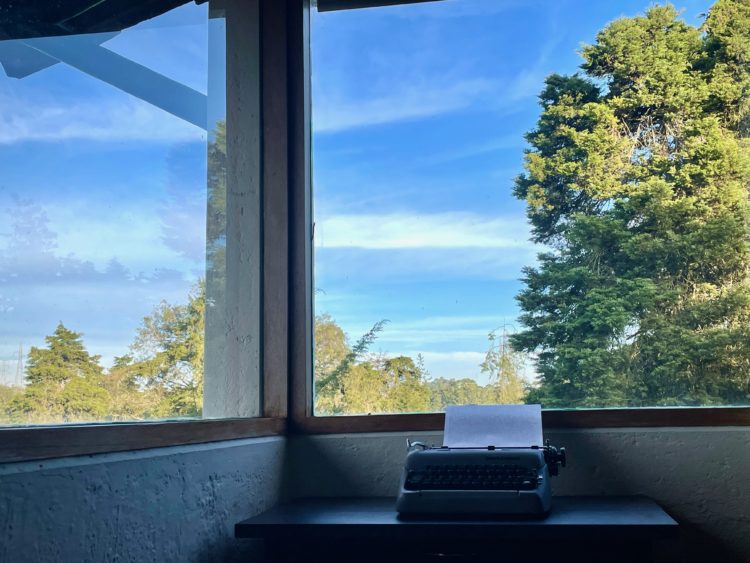
Will home ownership kill my creative productivity, or boost it?
My creative productivity has taken a major hit during the course of this transition, which has been going on for more than three months. There was the couple months I spent in nearby houses, away from the comfort of my home office, as I tested the concept and waited for closing. Then there was figuring out the process to actually buy the place, and the mental energy spent hoping it wouldn’t fall through.
Now that I’m here, there’s a potentially endless stream of projects that need to be planned and executed, if I’m to adapt this house to fit my vision. I’ve been able to keep up with my non-negotiable deliverables – Love Mondays newsletters and podcast episodes – but I’ve lost the bandwidth to otherwise make progress on the next book, and I feel my pipeline of original thoughts has slowed. I can feel my mental rigor slipping away, as I awaken from that hypnotic world of words I was in when most daily energy went towards reading and writing.
At times, I’ve wondered to myself if this has been just Resistance – that I’m complicating life to avoid hard creative work. I keep telling myself I’ve worked hard enough for long enough – and have been in limbo long enough – that I owe it to myself to create a home, especially when other symbols of “home” have been disappearing from my life.
It’s certainly a vast departure from that moment chronicled in Mind Management, Not Time Management, when I first arrived here in Colombia nearly seven years ago, to a full-service apartment, with nothing but a couple suitcases. I had control over almost nothing in that living space, but I had much less to think about.
I’m hopeful my creative productivity will recover. If all works out, I’ll complete many of the projects I have in mind to make this house suit the life I envision. Some of those projects will be relegated to “Someday/Maybes.” Many of the things I’m learning for the first time, such as how to repairs holes or hang a picture on a stucco wall, or who to call to do maintenance on the tankless water heater, will become second-nature. As tasks repeat, I’ll apply my own advice, and develop checklists and systems so that they practically take care of themselves. I’ll eventually have “front burner” space again.
I can already feel it happening as I write this. I’m certainly sleeping better, and longer than I thought I needed. I’m getting fresh air, and it’s quiet enough I can think. I’m re-hypnotizing myself to live in that world of words again. Maybe I’ll get even deeper this time.
Also, we’re getting close to the end of the year. I’m finishing up the November podcast episodes, and, as is customary, I’ll take December off from the podcast. That will be a good opportunity to have the space to recover my mind from a year of work and big changes, and put some things in place so I can start off 2023 productively, so the cycle can repeat next year.
The country is a big change
The biggest change of all is the setting in which I live. I can no longer walk to a cafe to do some work; a good Bachata-dancing night is more than an hour drive away; if I want to order food delivered, I better do it before 5 p.m.; and, though I have a friend next door, I have to overcome a lot of inertia to bother to go to a party in the city or dinner with other friends.
This feels like an end to a season in my life in which I challenged myself with the chaos of city life. For sixteen consecutive years, I downsized and forewent many comforts I was accustomed to, to be where the action was. I lived in San Francisco, Chicago, and Medellín, and spent a couple stints in New York.
All the while, I was relying more and more on the internet to get me what I needed. Then, the pandemic came, and everyone was doing that to the max. It made normal a lot of things that were unusual. Once I emerged back to “normal”, I was keenly aware that the pandemic had created ruts I should put forth effort to break out of.
But, I couldn’t get back to the same rhythm. Add to that, I had aged, nomad friends who were in town often stopped being so, and I started to feel like the old man at the hip cafes. And I came to prefer my home office for getting most things done, anyway.
I think I challenged myself for a long time with stimulation, and now I’m challenging myself with isolation. So far, so good, but I’m searching for the right combination of the things I want.
Going to 20 Books to 50k in Vegas!
I’m sure I’ll get more than enough stimulation in Vegas in November. I’m going to the 20 Books to 50k conference. I’m a little nervous about it: Sounds like an overwhelming conference, it will be almost entirely fiction authors, and Vegas is the exact opposite of my kind of place.
Add to that the long trip, and – as I sit in the comfort of my quiet home office with a view of nature – I downright don’t want to go in this moment. But I know I never want to go anywhere, and am usually glad I did.
I should make a prediction: I am 70% sure I will not regret going to the 20 Books to 50k conference. Yet, I am 70% sure I will not go to the 20 Books to 50k conference again in 2023. I’ve just gotten enough value out of conversations on the Facebook Group, I’d like to try the conference once. If you see me, definitely say hi!
New camera on the way!
With my move to the country, I’m thinking more about how I can better connect with people from afar. During one of my recent one-on-one intro calls – one method of connecting with people – a couple people I met with had amazing camera set-ups.
People who do lots of Zoom calls have really stepped up their webcam games! I got camera envy. More and more podcasts on which I’m interviewed are recording video, and my set-up is starting to look embarrassing.
Many years ago, I stepped up my webcam game with the very popular Logitech C920. But, it’s still merely a webcam. Support for real cameras as webcams has gotten much better (if it existed then at all).
The perfect webcam-compatible “real” camera
Finding the perfect webcam-compatible “real” camera turned out to be a big research project. I took photography in college, so at least know the basics about optics and the differences between major types of cameras, but I had a lot to learn to make the right purchase.
Some basics I learned:
- Many cameras have webcam support via their manufacturers’ software, but they tend to downgrade the resolution to a very-odd 576p.
- With a “capture card,” you can stream at higher resolutions, such as 720p, 1080p, and supposedly 4k. The Elgato CamLink is the most popular one.
- To connect to the capture card, you need HDMI out.
- But some cameras will display through HDMI output exactly what’s on the viewfinder screen (such as auto-focus boxes). For true support, you want “clean HDMI” out.
- Elgato has a list of cameras and their compatibility with the CamLink here.
- Some “real” digital cameras aren’t “DSLRs”, but rather “Mirrorless Digital Cameras.” (I already knew “Single Lens Reflex” cameras use a mirror – which snaps out of the way when taking a picture – to display through the viewfinder.)
- For streaming, it’s ideal to have a viewfinder screen that can point in the same direction as the lens – for checking your framing.
- Cameras have various-sized sensors: full-frame, crop, and Micro Four Thirds. The size of the sensor affects the effective lens length. For example, a Micro Four Thirds camera with a 17mm lens will look approximately like a full-frame camera with a 34mm lens.
There are an assload of people who stream themselves playing video games, and that’s good for me because they make lots of YouTube videos about ideal cameras for streaming. But boy, is this shit complicated and confusing. Thankfully, I didn’t have to learn about f-stop, depth-of-field, and why a “real” camera is so much better in the first place.
The winning camera: Panasonic Lumix G7
After lots of research, I chose to go with the Panasonic Lumix G7. It apparently has poor auto-focus, and no in-body image stabilization, but those aren’t important to me, as I don’t plan to do much moving around in my videos. (The lack of image stabilization worries me a little, as movement on the floor in my office is likely to shake a camera on my desk).
How do I get one in Colombia?
But, I had two problems: One was that any kind of electronics are extra-expensive to get to Colombia. Anything worth more than $200, you have to pay about a third in tax. The other was, I wasn’t crazy about the “kit” lens on the G7. It adjusts, from 14–42mm, which I take to mean lower-quality optics, and it only goes down to f3.5, which means you won’t get that shallow-depth-of-field blurred background that all the kids on YouTube are calling “bokeh.”
First, I tried looking for a used one locally on Facebook Marketplace. But in the image on the posting of the one I found, you could barely make out all but a couple letters on the serial number. I asked the seller for a closer picture: still can’t see it. I asked him if he could read it himself: nope.
Yes, the serial number would be on any EXIF metadata taken by that camera, but I wasn’t comfortable buying a used camera with no serial number (and no box and no receipt). Cameras are a uniquely great item to steal: they’re expensive, portable, and they aren’t registered with some central authority.
But anyway, the used cameras are expensive in Colombia, because import fees are priced in. I considered shipping a camera to my hotel in Vegas, in November. But, I’m impatient, and like to think my time is worth $600 an hour. I’d already spent a ton of time on this purchase, so it was time to get it over with.
I ended up finding a used G7, body-only, on eBay – serial number visible, not in any online databases as stolen. “Bought it Now,” and paid a good amount extra to not deal with an auction. I can choose my own lens (arguably the most important factor affecting quality), and I can save on import duties since I’m just importing a body, provided I import a lens worth less than $200.
Getting good “glass”
About that lens: I wanted a fixed length – “prime lens” – and figured I wouldn’t mind not having auto-focus. Both these things mean higher-quality “glass” for your money. I ordered the Venus Optics Laowa 17mm f/1.8 Micro Four Thirds lens for $150. At 17mm on the Lumix’s MFT sensor, that should look about like a 35mm lens. And it goes down to f1.8, which may even be too shallow-depth-of-field. We shall see.
So now the camera and its lens and my CamLink and a dummy-battery-to-AC-adapter and a desk stand are all on their way. I already have some lights. Overall, I’ll end up spending about $700 for a used camera and a fixed lens. If I lived in the U.S., I could get a new G7 with kit lens – delivered in two days – for $600.
This was a lot to research and I’m excited to see how it turns out. I can’t believe it’s still this complicated. It’s strange to have to adapt a product that’s mostly for taking photos – which I have no interest in – to do this very specific thing a ton of people need. I can’t understand why there’s not some kind of webcam/point-and-shoot hybrid that gets us 95% the way to “real” camera quality.
Maybe I’ll make a video sharing my findings. In any case, I’ll share a before-and-after in next month’s report.
Why not use your iPhone and Continuity Camera?
You might wonder why I don’t use my iPhone and the new Continuity Camera feature. The main reason is, I’m reluctant to update my laptop to Ventura (which is still in beta, by the way).
The first reason I’m reluctant to update my OS is, I still have Adobe software I’ve paid for that I still want to be able to use. If I update my operating system (I’m on Mojave – four major releases old), I’ll have to start paying monthly for Creative Cloud.
I’ve weaned myself off Adobe products for any new projects (thank you, Affinity). But, I still have legacy projects I may want to make a change on from time-to-time (for example, HTS is laid out in InDesign).
Even if I were willing to update to Ventura, my computer isn’t compatible. I have a mid-2014 MacBook Pro, and Ventura requires a 2017 or newer.
Additionally, as impressive as the picture quality you can get from an iPhone with their little lenses, I just really want the extra quality of a real camera with a real lens. And the iPhone’s fake bokeh effect? Barf.
Time for a new laptop?
All the above said, maybe I should update my laptop (and, by extension, my OS). I’m not sure how well this one will handle streaming via a professional camera, and the last time I used Descript, it was nearly unusable.
I’ve been resistant to post-Steve Jobs MacBooks. The touch bar is of no use to me, since I hardly use my laptop as a laptop. But, since I’m not traveling a lot, I could spring for a larger screen. I’m going to mull it over – and maybe it’s not so bad if I have to shell out a little to edit a legacy file in Creative Cloud once in a while. I’m making decent money now.
Waiting on ActiveCampaign payments
I didn’t receive a payment from ActiveCampaign this month, and I haven’t received one in October, either. According to my estimates, I was due to receive about $900 this month, and $2,700 in October. So, ActiveCampaign owes me about $3,600.
I did some digging, and found that ActiveCampaign recently changed some affiliate rules that may prevent me from receiving any future payments. But, I’ve contacted the team, and it looks like we might have cleared that up.
Perhaps I will receive a big payment at the beginning of November. According to my estimates, if I got paid for September, October, and November all at once, I would get about $4,800. That would probably be a record month, especially if I end up running a Black Friday deal on my courses.
The Heart to Start Kindle Deal in December
I’ve been getting a steady stream of nominations for Kindle Deals in various non-U.S. markets. Those don’t cause big spikes in revenue. But, I recently received a nomination for HTS to be a U.S. deal sometime in December.
I’ve written about my Kindle Deal experience before, and the two I’ve had in the U.S. have been positive. HTS was a Kindle Daily Deal in 2020, and MMT was a Kindle Monthly Deal in March of this year. I estimated that I made an extra $575 from my HTS deal, and as far as I can tell, I merely sold a lot more copies of MMT during its monthly deal.
Higher podcast editing expense
Podcast editing this month was $163, rather than the usual, $123. This was because the David Perell interview I released was much longer than most episodes. I think it turned out great, so thank you to our Patreon supporters, as their contributions are enough to pay for the extra editing expense.
Next month’s podcast editing bill will also be higher, to pay for the extra length of the podcast version of my recent AMA.
Design for Hackers royalties
I got my bi-annual royalty payment for Design for Hackers in September: $406. The previous two payments were $589, and $648, so that appears to be trending down.
Thank you for having me on your podcasts!
Thank you for having me on your podcasts. Thank you to Ivan Farber at Conversations About Conversations, and David Elikwu at The Knowledge.
As always, you can find a list of all my podcast appearances here.
Income
Book Sales
| Mind Management, Not Time Management Kindle | $3,160 |
| Mind Management, Not Time Management Paperback (Amazon) | $888 |
| Mind Management, Not Time Management (non-Amazon) | $425 |
| Mind Management, Not Time Management Audiobook | $578 |
| Digital Zettelkasten Kindle | $568 |
| Digital Zettelkasten Wide (non-Kindle) | $124 |
| Digital Zettelkasten Audiobook | $70 |
| The Heart to Start Kindle | $501 |
| The Heart to Start Paperback (Amazon) | $93 |
| The Heart to Start “Wide” (non-Amazon) | $136 |
| The Heart to Start Audiobook | $54 |
| How to Write a Book Kindle | $86 |
| How to Write a Book Paperback | $68 |
| How to Write a Book “Wide” (non-Amazon) | $12 |
| How to Write a Book Audiobook | $22 |
| How to Write a Book Spanish (all) | $10 |
| Make Money Writing on the STEEM Blockchain (all) | $1 |
| Ten Passive Income Ideas | $11 |
| Design for Hackers (all formats) | $406 |
| Total Book Sales | $7,212 |
Digital Products
| White Hot Course | $39 |
| Summer of Design | $9 |
| Total Digital Products | $48 |
Affiliates / Advertising
| Active Campaign | $0 |
| Alliance of Independent Authors | $0 |
| Amazon | $111 |
| Google AdSense | $106 |
| Hostgator | $100 |
| SendOwl | $5 |
| Total Affiliates | $322 |
Love Your Work Podcast
| Patreon | $213 |
| Total LYW Podcast | $213 |
Services
| Clarity | $0 |
| Medium | $0 |
| Total Services | $0 |
| GROSS INCOME | $7,795 |
Expenses
General
| Accounting | $0 |
| Outside Contractors | $0 |
| Podcast Editing / Publishing | $163 |
| Quickbooks | $45 |
| Total General | $208 |
Advertising
| Amazon | $3,357 |
| Total Advertising | $3,357 |
Hosting
| ActiveCampaign | $135 |
| Bookfunnel | $15 |
| Drafts | $2 |
| Dropbox | $10 |
| Fathom Analtyics | $14 |
| Libsyn | $7 |
| Namecheap | $26 |
| SendOwl | $9 |
| Typeform | $26 |
| Ulysses | $7 |
| WP Engine | $96 |
| Zapier | $14 |
| Total Hosting | $361 |
| TOTAL EXPENSES | $3,926 |
| NET PROFIT | $3,869 |


